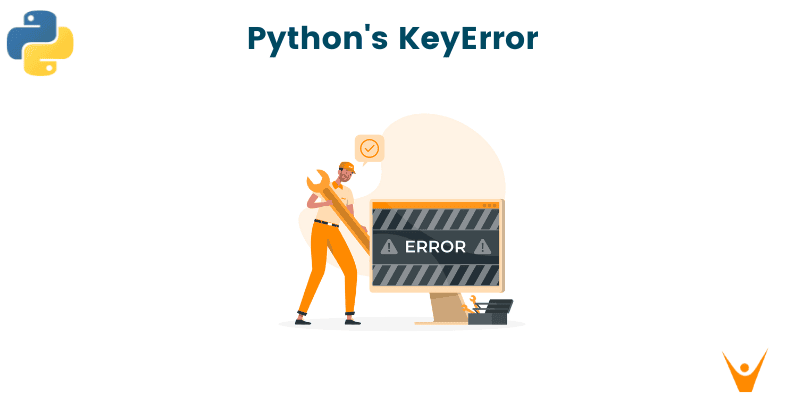Python is a versatile programming language known for its simplicity and readability. However, like any programming language, it is not immune to errors. One common error that developers often encounter is the Keyerror exception. This exception occurs when an attempt is made to access a key that does not exist in a dictionary. In this article, we will explore the causes of Keyerror exceptions, various methods to handle them, and best practices to prevent them from occurring.
What is a KeyError in Python?
When an error occurs in python, developers refer to it as “throwing an error’. KeyErrors are pretty common errors for beginners.
A KeyError is thrown when a program or code tries to access a key that is not present in a specified dictionary. A dictionary in python is a data structure that stores key-value pairs. Every key is unique and has a value associated with it. When a KeyError is raised, it means that the specified key is not found in the dictionary and therefore the program is unable to retrieve the value associated with it.
Here’s an example of a code that would throw a key error:
my_dict = {'apple': 1, 'banana': 2, 'orange': 3} print(my_dict['grape'])
In the above example, we have created a dictionary called ‘my_dict’ and given it three key-value pairs. We then tried to ask the program to print the value associated with the key ’grape’. Obviously, this would be a source of confusion for the compiler as the key ‘grape’ does not exist. Therefore it raises a KeyError.
Reasons for KeyError Exceptions
The primary reason for a KeyError exception is attempting to access a key that does not exist in a dictionary. This can happen due to various reasons, such as:
- Misspelled or incorrect key: If you accidentally misspell a key or use an incorrect key, Python will not be able to find the corresponding value in the dictionary, resulting in a KeyError exception.
- Dynamic key retrieval: In some cases, you may retrieve keys from user input or other sources dynamically. If the retrieved key does not exist in the dictionary, a KeyError exception will occur.
- Inconsistent data or data manipulation: If you manipulate the data in a way that removes or modifies keys in a dictionary, accessing those keys later could lead to a KeyError exception.
Now that we have a clear understanding of KeyError exceptions and their causes, let's explore various methods to handle them effectively.
How to handle KeyError in Python?
Let's now look at some of the ways to fix the KeyError easily.
Method 1: Using the in Keyword
The best way to fix KeyError is to Check if the key exists. This can be easily done using the ‘in’ operator. It has a very simple syntax [value in sequence]. Essentially we are checking to figure out if the requested value or key exists in the sequence or dictionary.
Here is an example:
fruits= {'apple': 1, 'banana': 2, 'orange': 3} If 'grape' in fruits: print(fruits['grape']) else: print('Key not found')
Output:
Key not found
This code checks to see if the key "grape" is present in the dictionary "fruits" using an if-else statement. For example, if the key is present in "grape," print "grape," else, print that it is not present. Also, we have a detailed article on how to check if a key exists in a dictionary in Python.
Method 2: Using the get() Method
You can also implement the get() method to solve KeyError. The get() method is a simpler way of doing the same thing as the if-else statement, just shorter and written in one line. It has the option of returning a default value that has to be specified by the user after the key name.
Understand it with the following code:
fruits= {'apple': 1, 'banana': 2, ‘orange’: 3} print(fruits.get('grape', 'Key not found’))
Output:
Key not found
In this block of code, we first create a dictionary called ‘fruits’. Then we print the ‘grape’ key from fruits. In case the ‘grape’ key is not present in the dictionary, as is the case, the default response that we have given, ‘Key not found’ is printed for the user to see.
Method 3: Using the defaultdict
There is one more method to fix KeyError by using the defaultdict class. This class is found in the collections module. If a user attempts to call a key that doesn't exist in a standard dictionary, a key error is raised. Here is an example:
from collections import defaultdict fruits = {'apple': 2, 'banana': 3} d = defaultdict(int) for key in fruits: d[key] = fruits[key] print(d['orange']) for key, value in d.items(): print(key, value)
Output:
0 0 apple 2 orange 0 banana 3
Here, we created a dictionary called "fruits," gave it values, and then added them to the defaultdict after first importing the defaultdict class from the collections module. With the defaultdict, if we try to access a key that doesn't exist, like "orange," we get the value "0" by default. Lastly, we are using a for statement to loop through all of the dictionary's accessible values.
How to Ignore KeyError?
Ignoring coding errors is not advised, especially for novice users, as it can result in unexpected outcomes and the programmed code may metaphorically break down. A try-except block of code will be useful in cases of lengthy codes, where we are left with no other options.
A try-except block is a structure in programming that is used for handling any faults or exceptions that can arise while a program is being executed. The block of code that is placed in the ‘try’ block may or may not contain an error. If the compiler finds no error in the ‘try’ block, it will ignore it and move on as normal.
If there are any errors, the compiler looks at the ‘escape’ block and tries to find if that error has been specified. If it has been specified, the compiler handles the error as per what the user has coded. The following is the syntax:
try:
# code that may raise an exception
except ExceptionType:
# code to handle the exception
And here’s an example:
my_dict = {'apple': 1, 'banana': 2, 'orange': 3} try: print(my_dict['grape']) except KeyError: print('Key not found')
Output:
Key not found
Here, we specify what the compiler should do if the portion of code inside the "try" block has an error. A print statement that we defined will only print if a KeyError occurs. We have specified only a KeyError in the except block. After printing the output of the statement, the compiler will proceed to ignore this block of code and move on to the following block.
Best Practices to Prevent KeyError Exceptions
While it is essential to handle KeyError exceptions effectively, it is even better to prevent them from occurring in the first place. Here are some best practices to follow to avoid KeyError exceptions in your Python code:
- To ensure that the keys you are accessing in a dictionary exist, validate the input before using the keys. If you are retrieving keys from user input or other external sources, perform appropriate checks to verify the existence of the keys in the dictionary.
- Misspelled or incorrect keys are a common cause of Keyerror exceptions. To minimize the chances of misspelling keys, follow proper naming conventions and use descriptive key names.
- If you manipulate data in a way that removes or modifies keys in a dictionary, ensure that you account for those changes in your code. Validate the integrity of the dictionary after data manipulation to avoid accessing missing keys.
Conclusion
Handling KeyError exceptions effectively is essential for robust Python programming. By following the methods and best practices outlined in this comprehensive guide, you can gracefully handle KeyError exceptions, prevent program termination, and provide meaningful responses to users. Remember to validate input, use proper naming conventions, and validate data manipulation to minimize the occurrence of KeyError exceptions in your code.








